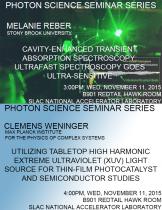Speaker: Melanie Reber, Stony Brook University
Program Description
Ultrafast transient absorption spectroscopy, in which the changes in a probe pulse traversing an excited sample are recorded, is the most widely applied technique for observing femtosecond (and now attosecond) dynamics. However, transient absorption spectroscopy is largely limited to condensed-phase samples due to the optical densities required for recording a signal. Using a frequency comb and optical cavities, we have improved upon the sensitivity of transient absorption spectroscopy by nearly four orders of magnitude. We can now undertake all-optical experiments on a wide variety of gas phase species produced in molecular beams, such as clusters, radicals, and ions. I will discuss the physical principles and experimental details of this new technique as well as present results from a demonstration experiment in molecular iodine, reaching a minimum detectable change in absorbance of ΔOD = 2×10-10, while still exciting a large fraction (~1%) of the molecular ensemble.





